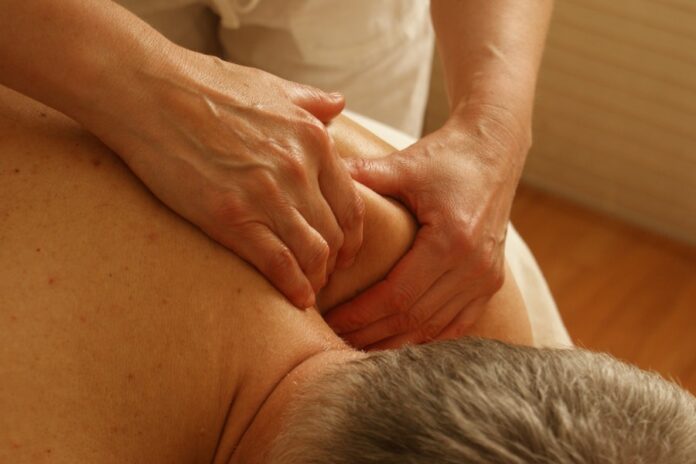Massage is a key component of injury rehabilitation therapy. It helps reduce the risk of a re-injury and accelerates the healing process.
Soft-tissue injuries are very common after a sports-related injury, so receiving regular massage therapy treatments will decrease the risk of soft-tissue injuries and help the athlete return to doing what they love most.
Specifically, sports massage therapy is a therapeutic modality that focuses on helping injured athletes recuperate quicker while helping maximize their athletic performance.
How Massage Therapy Helps Heal and Prevent Sports Injuries
Massage therapy will help athletes recover from surgery as fast as possible. It helps athletes deal with their joint pain, and reduces swelling in the event of a muscle pull.
Biomechanical imbalances will be addressed, and areas of tightness will be evaluated and remedied. Therapeutic treatments will be prescribed in order to maximize your range of motion and help return your body to equilibrium.
Self-massage techniques and foam rollers may be recommended according to your unique body type, athletic performance, and skill level. Injury prevention is a crucial component of massage therapy in order to prevent sports injuries from occurring in the first place.
Athletes will be taught how to reduce the amount of recovery time between their workouts so that they can recover faster. They will be taught how to decrease any muscle tightness that they are experiencing while they train.
Once an elite athlete has attained an optimal level of fitness, they must be taught how to maintain said level of fitness for as long as possible.
Maintenance is also a pertinent component of massage therapy, as maintaining peak levels of performance will lessen the risk of injuries in the future.
In the event that the athlete is injured, their physiotherapist will perform specialized massages in order to help relieve their pain. They will target areas of pain and inflammation, and apply the necessary pressure in order to reduce any discomfort.
Muscle tissues will be stretched and blood circulation will be improved via massage therapy in order to prevent the aggravation of the sports-related injury and speed up healing.
How Massage Therapy Impacts Athletic Performance
Massage therapy helps boost muscle flexibility. Muscle fibers will be stretched by a trained professional. Massage therapy also helps improve the range of motion of the athlete so that they will be able to perform at optimal levels.
Muscle reflexes will be toned mechanically by the expert, thus helping the athlete move effortlessly while they are competing or training. When flexibility is lacking, it causes muscle fibers to form knots. These knots will greatly hinder the range of motion of the athlete, which will subsequently affect their ability to perform.
Moreover, massage therapy will reduce muscle fatigue.
Lactic acid secretions, when left untreated, will damage bodily tissues over time. The end result is subpar circulation within the athlete’s muscles. Tissues become restricted and shorter, leading to stiffness and soreness that will hinder performance. The good news is that regular massage therapy will help prevent the buildup of lactic acid in the body. It also prevents the accumulation of other harmful toxins in order to reduce muscle tension and pain.
Additionally, mental health can be improved via massage therapy. Pain and stress will hinder your ability to focus, train, and perform. Sports massage therapy has been shown to trigger the parasympathetic nervous system, reduce the production of stress hormones (i.e., cortisol), declutter the mind, and relax the body.
As can be seen, the benefits of massage therapy are wide-ranging and vital to improving athletic performance.
How Massage Therapy Helps Rehabilitate Injuries
Massage therapy reduces pain, inflammation, and swelling, while also helping release toxins from the body. It assists the body in recovering quicker after an injury by promoting optimal blood circulation and by decreasing muscle and joint stiffness.
It is commonly used in order to treat repetitive strain injuries, soft tissue injuries, lower back pain, tennis elbow, knee pain, and rotator cuff tears, for example.
As for the stages of rehabilitation, the first step consists of resting the body and protecting the injury from getting worse. Next, you should shift gears towards recovering your motion. The third stage involves focusing on regaining your lost muscle strength. In the final stage, you should concentrate on recovering your functionality so that you can return to training at elite levels.
Pre- and post-surgery rehabilitation may involve LASER, IFT, TENS, neuromuscular electrical stimulation, ultrasonic therapy, and the use of custom-tailored orthotic devices in order to help the patient recover faster.
Manual therapy is also very common, with the therapist working on localized tendons and joints in order to optimize blood circulation. Manipulation and mobilization techniques will be used by the licensed and highly trained physiotherapist to remedy stiff joints and massage damaged tissues.
The athlete will be closely supervised while they sit, walk, stand, and lie. Any areas of weakness will be identified and addressed as soon as possible in order to ensure that the athlete continues to improve according to schedule.
Sensory stimulation therapy may be administered in certain cases. Coordination is also a key area of focus, as the athlete will be taught exercises that will help them restore balance and coordination.
The end goal of physiotherapy is to help the athlete fully recover from their injuries and return to peak athletic performance, while also teaching them how to prevent subsequent injuries from occurring.
Conclusion
Massage therapy should be included as part of the fitness routine of every athlete.
In sum, it helps facilitate the recovery and relaxation process after workouts, reduces fatigue, swelling, and muscle and joint stiffness, decreases the risk of injuries, and ultimately helps athletes achieve peak levels of performance.








![Avast Driver Updater Key 2022 | Activation Key V2.5.9 [Free]- Avast Driver Updater Key 2021](https://vintank.com/wp-content/uploads/2021/02/Avast-Driver-Updater-Key-2021-100x70.jpg)
![Avast Premier Activation Code and License Key [Working] Avast Premier Activation Code and License Key](https://vintank.com/wp-content/uploads/2021/09/Avast-Premier-Activation-Code-and-License-Key-100x70.jpg)
